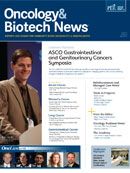Adjuvant Chemotherapy in Breast Cancer-Or Not?
Adjuvant chemotherapy improves disease-free and overall survival in many--but not all--patients with breast cancer.
Edith A. Perez, MD
Adjuvant chemotherapy improves disease-free and overall survival in many—but not all—patients with breast cancer. And that, according to Edith A. Perez, MD, deputy director of the Mayo Clinic Cancer Center in Jacksonville, Florida, is the problem: Evidence for which patients will benefit from adjuvant chemotherapy and which will not is not yet clear, and reliable predictive and prognostic markers are still under development.
“Not giving chemotherapy when necessary can lead to severe adverse consequences,” said Perez in a presentation at the 9th Annual Northern New Jersey Breast Cancer Conference at the John Theurer Cancer Center in Hackensack. “But you don’t want to use chemotherapy if you don’t need to use it.”
Classic strategies to evaluate whether or not a patient should receive adjuvant chemotherapy involve basing the decision on parameters such as tumor size, nodal status, and the patient’s overall condition. But clinical trials now under way will soon aid in our understanding of the use of biomarkers in determining therapy, Perez said.
The TAILORx (Trial Assigning IndividuaLized Options for Treatment [Rx]) study enrolled 10,500 women with early-stage, node-negative, estrogenreceptor— positive breast cancer. All tumors were evaluated with the Oncotype DX Assay. The trial is designed to evaluate the effect of hormonal therapy alone versus hormonal therapy and chemotherapy in patients with an intermediate recurrence score. Results are expected in 2015.
MINDACT (Microarray In Node-negative and one to three positive lymph node Disease may Avoid ChemoTherapy), a prospective randomized trial, investigated discordance between tumor size and genetic assays in node-negative breast cancer. The trial compared the 70-gene signature risk with common clinical-pathological criteria in selecting patients for adjuvant chemotherapy. MINDACT, which was recently completed, enrolled 6000 women; results are not yet published.
Another trial currently under way, S1007, (SWOG RxPONDER Trial, or Rx for Positive Node, Endocrine Responsive Breast Cancer), will evaluate use of adjuvant endocrine therapy with and without chemotherapy in patients with hormone-receptor-positive, HER2-negative breast cancer. Specifically, the trial will evaluate women with recurrence scores ≤25 and one to three positive nodes. Approximately, 9400 patients will be screened to randomize 4000. Currently, said Perez, approximately 250 patients are enrolled.
Until the results of these trials are published, currently available evidence is incomplete. Albain and colleagues retrospectively analyzed data from the phase III SWOG-8814 trial to determine the effect of recurrence score on disease-free survival according to treatment group (cyclophosphamide, doxorubicin, and fluorouracil [CAF] plus tamoxifen, or tamoxifen alone). SWOG-8814 enrolled postmenopausal women with node-positive, estrogen-receptorpositive breast cancer. In the tamoxifen-only group, the recurrence score was prognostic for patients with positive nodes, and predicted a significant benefit from CAF in tumors with a high recurrence score. A low recurrence score identified women who may not benefit from the chemotherapy regimen, despite positive nodes. But, noted Perez, despite these findings, in her practice she still recommends chemotherapy, adding that these results need to be addressed in a prospective trial.
“
Not giving chemotherapy when necessary can lead to severe adverse consequences. But you don’t want to use chemotherapy if you don’t need to use it. ”
—Edith A. Perez, MD
The EBCTCG 2010 overview also provided no clear answers, Perez said. Although the overview indicated that adjuvant treatments do work, for the most part, there was no way to identify which patients could forgo treatment. At the same time, Perez said, poor reproducibility in biomarker measurement could be leading to the wrong conclusions. “The data are not as clear as some may have thought.”
“This is a challenge,” said Perez. “We don’t have the real data today. We have to analyze the genes of all patients to know which patients will not benefit.”
Until that information is available, Perez recommended that oncologists be judicious about whether or not to use chemotherapy in the adjuvant setting; remember that the stakes are high; await data from TAILORx, MINDACT, and S1007; and keep in mind that less may not be the best for many patients. “I use the best data that I have and build from there,” she said.




